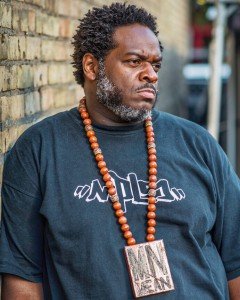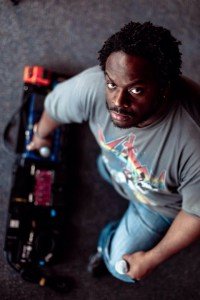By JAN WILLMS
An imposing strength and a fierce look on the face of Carnage the Executioner reflect the image of his name as the rapper performs onstage. But when a smile breaks out, the gentle soul of Terrell Woods, the man, comes shining through.
 Photo left: Carnage the Executioner (Photo by Mike Madison)
Photo left: Carnage the Executioner (Photo by Mike Madison)
Born in Chicago, Woods moved with his mom to St. Paul when he was around 5. “We lived in the Midway area, on Sherburne Ave. I first went to school at Maxfield,” he recalled.
But life was not easy, and as his mother struggled with alcoholism and addiction, Woods was placed in foster care at age 12. This was the beginning of moves throughout the Metro, from St. Paul to North Minneapolis to South Minneapolis and back and forth, as Woods lived in foster homes and group homes.
“I learned how to survive in the system,” Woods said. “I did some things to fit in, but never robbed or killed anybody or went to prison. Most of the kids were quite a bit more unruly than me, and I was good at staying afloat and making friends.”
One of the survival tactics Woods relied on was his love of music. “As early as I can remember I would hear certain songs. My mom wasn’t a musician, but she played a lot of the music that was popular and that I liked.”
“The first thing I wanted to do was play drums. I was 5 or 6, and I would set up pillows on the couch when my mom wasn’t home, and I would turn on the TV and get wooden spoons and hit the pillows, playing fake drums to every song on TV.”
He listened to Herbie Hancock and Run-D.M.C., one of the most well-known hip-hop acts of the 1980s. “I was at a friend’s house, and his dad was playing that group. I remember the beat. That was my first introduction to hip-hop, and I asked his dad to play it again and again and again.”
When Woods was as young as 8, he started working on the art he has perfected today, beatboxing, making drum sounds with his mouth. “I started teaching myself,” he said.
 Photo right: Photo by Sarah Dope
Photo right: Photo by Sarah Dope
As well as wanting to be a drummer, he wanted to be a DJ, one of the other elements of hip-hop culture. “I was also getting into breakdancing, and the DJs were the ones spinning the records for the break-dancers,” Woods noted. “But drums and turntables were expensive, and I couldn’t afford them. So beat box came around right when it was supposed to because I could do that without buying an instrument.”
He was not yet in his teens, but as he entered high school in Bloomington, he became more involved with hip-hop, and he started writing his own songs. He was a senior when he recorded his first song.
And, although music was such a big part of his life, Woods was still thinking of it as a hobby. He started Hamline University, studying psychology.
“I didn’t see how studying music in college would really help me,” he reflected. “I needed a backup if something happened with the music, and having education as a foundation was important to me. I thought I would get a good job, and music would just be fun. But I never gave it up.”
He completed his first album while attending Hamline, and when he graduated in 1997, he began a career in social services. He returned to the foster care and group home system in which he had grown up, but this time as a social worker. “I thought it would be cool to work at all the places I had lived as a kid,” Woods said.
However, performing as a rapper was in his blood, and he could not let it go. He said he thought of how the hip-hop culture had helped him survive his childhood, and he wanted to give back to that culture. Finally, in February 2007, he took the step to make his living as a musician.
He has performed with Desdamona, providing backup sound to her spoken word. And he was close to Micheal “Eyedea” Larsen, the multi-talented Minneapolis rapper who died tragically in 2010. As he gained experience from working with other performers, he was honing his skills for his own songs, albums, and solo work.
 Photo left: Photo by Patrick Pegg
Photo left: Photo by Patrick Pegg
Woods is a strong believer in the basis of respect that is so much a part of hip-hop, and his music has drawn the respect of fellow artists. “I’m your favorite rapper’s favorite rapper,” he claims. “I don’t know any of my peers who don’t respect what I do.”
For many of his songs, Woods has drawn on his own past to create his volume of work. And he has drawn on his past in choosing his performing name, Carnage the Executioner.
“When I first came up with the name, I wanted something flashy and abrasive and memorable,” he said. “It didn’t take me too long to start figuring out how to justify the name, and it turned from just sounding cool to having some meaning.”
Woods describes it as being about a journey from where he came from and to where he is going. “Where I came from, there has been a lot of carnage in my life,” he explained. “As I have gotten older, I realize that if you don’t grow from your past, you are just a puppet to it. You become a victim of your circumstance.”
“I made it through every possible peril that was presented to me. So the name started having the symbolic message of a journey. I have learned to deal with carnage. Carnage is the artist; Terrell Woods is the person,” he said.
In listening to Woods perform as Carnage, the sounds he creates with his mouth can provide a full musical background for his words. He could be called the Bobby McFerrin of hip-hop. In forming his sound, he likes loop, allowing him to make a sound and play if over and over like a backdrop. He has added an effects pedal that he hits with his foot. “It’s kind of like a keyboard but has a pedal that I operate with my feet.
With it, if I wanted something to sound like a crazy spaceship, I can do it,” Woods said. “It adds texture to the performance.”
“I think I can stay true to the culture by staying true to myself and do music for a wider base of people,” he commented. “I’m about trying to connect with people. It’s important. If someone spends four minutes listening to a song, that’s four minutes they can’t get back. If they’re going to put their money on you, you have to make it worth their while.”
Besides writing songs and performing, Woods teaches youth how to beat box and still draws on his social work skills and experience. He has worked with McPhail and the Stepping Stone Theater Company, and he has a record deal in France, where he is a staple in French hip-hop. He said he loves to perform, enjoys being in the studio and writing. The hardest part is marketing himself, trying to be seen and be known.
“I can only speak for how hard I work to be this good and how many years I have put in,” he noted. “I do this for other people’s enjoyment.”
Having done much of his performing in Minneapolis, Woods is now living in a St. Paul suburb and focusing many of his concerts on this side of the river. “St. Paul should be ready to give me a chance—they’re going to see a lot more of me,” he quipped with a smile.
Comments
No comments on this item Please log in to comment by clicking here